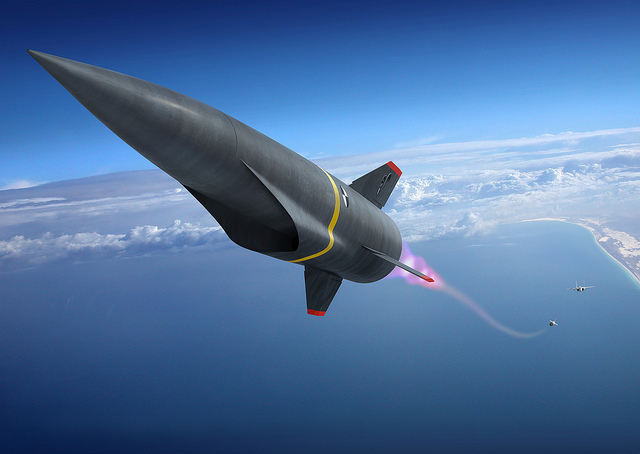Not long ago, I wrote a post titled Missile Defense Isn’t the Only Weapons System That Undermines Nuclear Deterrence. I was referring to U.S. development of hypersonic missiles, which, at five to 10 times the speed of sound, aren’t quite as fast as ballistic missiles (often mounted with nuclear warheads). As Mark Gubrud writes at the Bulletin for Atomic Scientists:
In the US, hypersonic missiles have been billed as a method for quickly delivering conventional warheads when time is of the essence; one example often given is attacking a terrorist stronghold promptly when intelligence indicates the opportunity to kill a high-value target.
In other words, they’re a method for adapting the speed of a nuclear weapons attack to specific targets instead of areas, which along with terrorists, include, in Gubrud’s words (from my previous post):
… strategic military targets within the territory of a major military power, including … key radars and associated systems, command and control nodes, long-range surveillance systems, and … ships in port.
Proponents claim:
… that the use of hypersonic weapons with conventional warheads (or pure kinetic energy) would permit such attacks to be carried out on the home territory of a nuclear power without the risk of a nuclear response.
Why do they believe that?
The vague reasoning is that the different flight profile of these weapons would distinguish them from nuclear ballistic missiles, and the Chinese (or Russians, in some other scenarios) would trust that American hypersonic missiles do not carry nuclear warheads.
In fact, though
US non-nuclear hypersonic weapons could well be targeting nuclear weapons and supporting facilities, possibly in preparation for a follow-on nuclear strike. Furthermore, there is no physical reason why hypersonic missiles could not deliver nuclear warheads.
Thus
Chinese and Russian officials have indicated they fear that US hypersonic weapons could be used to lead a nuclear first strike, and both those countries have begun hypersonic missile programs of their own, suggesting that, absent controls, a full-scale hypersonic arms race is just around the corner.
More to the point, hypersonic missiles are viewed as a way of emulating a nuclear strike with conventional weapons (or as Gubrud explains above, of emulating a conventional strike with nuclear weapons). Gubrud again:
The idea that they might be used to attack a nuclear power, because they would be easily distinguished from ballistic missiles and the enemy would be willing to believe that no hypersonic weapon carried a nuclear warhead, can hardly be considered stabilizing. Rather, it is a challenge to nuclear deterrence and a threat that potential adversaries have to take seriously. They will respond by seeking countermeasures, including symmetrical capabilities, as China and Russia are doing, via their own hypersonic missile programs.
The development of hypersonic missiles resembles the development of missile defense in that the United States thinks other countries make too big a deal out of it and refuses to see how it might be a threat to other states. But, Gubrud maintains
To imagine that a strategic attack could be carried out on military forces based in the homeland of a major nuclear power without the risk of a nuclear response is a dangerous fantasy. But the race to develop and deploy hypersonic weapons is serious.
In an October 15 piece at Stars and Stripes titled Hypersonic weapons could create new arms race, Lt. Col. Jeff Schreiner of the Stimson Center elaborates on that.
If deployed in sufficient numbers, they could upset the relative stability believed to exist between major powers due to their ability to survive a nuclear attack and retaliate with a devastating attack of their own. While hypersonic technology does not represent the catastrophic destructiveness of nuclear weapons, it has the potential of necessitating drastic changes in nations’ defense policies by raising doubts about their retaliatory capability.
Also:
The tactical planner in me sees countless uses for hypersonic delivery platforms against a range of target sets. The strategic planner sees the ability to help offset other nations’ strategic assets with a conventional versus nuclear strike. The pessimist in me sees a technology that has the potential to spiral out of control in many nations into deadly new nuclear delivery platforms.
Gubrud calls for an international ban on hypersonic missiles and proposes “that the United States suspend testing for a while, to show good faith as it seeks agreement on an international ban on hypersonic testing.” Schreiner echoes that:
What if the nations involved decided to take action to prevent a hypersonic arms race? A possible model to consider is the Comprehensive Test Ban Treaty. Treaties take time to negotiate, so a declared moratorium on testing would be a good start and something that could be easily monitored by all.

